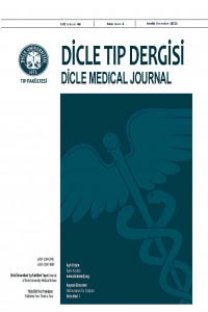Anorektal malformasyonlu olgularda klinik deneyimimiz: 115 olgunun analizi
Our clinical experience on anorectal malformations: Analysis of 115 cases
___
- 1. Wijers CH, de Blaauw I, Marcelis CL, et al. Research perspectives in the etiology of congenital anorectal malformations using data of the International Consortium on Anorectal Malformations: evidence for risk factors across different populations. Pediatr Surg Int 2010;26:1093-1099. Doi: 10.1007/s00383-010-2688-2690.
- 2. Marc A Levitt, Alberto Peña. Anorectal malformations. Orphanet J Rare Dis 2007;2:33. Doi: 10.1186/1750-1172-2-33
- 3. Stephens FD, Smith ED. Classification, identification and assesment of surgical treatment of anorectal anomalies. Pediatr Surg Int 1986;1: 200-205.
- 4. Boocock GR and Donnai D. Anorectal malformations: familial aspects and associated anomalies. Arch Dis Child 1987;62:576-579.
- 5. Naveli Y, Friedman A. Familial imperforate anus. Am J Dis Child 1976;130:441-442.
- 6. Murken JD, Albert A. Genetic counseling in cases of anal and rectal atresia. Prog Pediatr Surg 1976;9:115-118.
- 7. Carter TC, Kay DM, Brown ML, et al. Anorectal atresia and variants at predicted regulatory sites in candidate genes. Ann Hum Genet 2013;77:31-46. doi: 10.1111/j.1469- 1809.2012.00734.
- 8. Berdon WE. The radiologic evaluation of imperforate anus. Radiology 1968;90:466.
- 9. Boraedis AG, Gershon-Cohen J. Aeration of respiratory and gastrointestinal tracts during the first minute of neonatal life. Radiology 1956;67:407.
- 10. Hassink EA, Rieu PN, Hamel BC, et al. Additional congenital defects in anorectal malformations, Eur J Pediatr 1996;155:477-482.
- 11. Hoekstra WJ, Scholtmeijer RJ, Molenaar JC, et al. Urogenital tract abnormalities associated with congenital anorectal anomalies. J Urol 1983;130:962-963.
- 12. Mittal A, Airon RK, Magu S, et al. Associated anomalies with anorectal malformations, Indian J Pediatr 2004;71:509-514.
- 13. Nah SA, Ong CC, Lakshmi NK, et al. Anomalies associated with anorectal malformations according to the Krickenbeck anatomic classification. J Pediatr Surg 2012;47:2273-2278. doi: 10.1016/j.
- 14. Adkins JC, Kiesewettr WB. Imperforate anus. Surg Clin North Am 1976;5:379-394.
- 15. Parrott TS. Urologic implications of anorectal malformations. Urol Clin North Am 1985;12:13-21.
- 16. Rich MA, Brock WA, Pena A. Spectrum of genitourinary malformations in patients with imperforate anus. Pediatr Surg Int 1988;3:110-113.
- 17. Cuschieri A. EUOROCAT Working Group, Anorectal anomalies associated with or as part of other anomalies, Am J Med Genet 2002;110:122-130.
- 18. Çiğdem MK, Önen A, Duran H. The mechanical complications of colostomy in infants and children, Pediatr Surg Int 2006;22:671-676.
- 19. Bischoff A, Levitt MA, Peña A. Update on the management of anorectal malformations. Pediatr Surg Int 2013;29:899- 904. doi: 10.1007/s00383-013-3355-z.
- 20. Nour S, Stringer MD, Beck J. Colostomy complications in infants and children. Ann R Coll Surg Engl 1996;78:526- 530.
- 21. Wilkins S, Pena A. the role of colostomy in the management of anorectal malformations. Pediatr Surg Int. 1988;3:105.
- 22. Stephens FD, Smith ED. Imperforate rectum: A new surgical technique. Med J Aust 1953 202-206.
- 23. Pena A. Surgical management of anorectal malformations: A unified concept. Pediatr Surg Int 1988;3.88.
- 24. Georgeson KE, Inge TH, Albanese CT. Laparoscopically assisted anorectal pull-trough for high imperforate anus- a new tech-nique. J Pediatr Surg 2000;35:927-931.
- ISSN: 1300-2945
- Yayın Aralığı: 4
- Başlangıç: 1963
- Yayıncı: Cahfer GÜLOĞLU
Akut akromioklaviküler eklem çıkıklarında endobutton ile tesbit yöntemi
Raif ÖZDEN, Vedat URUÇ, İbrahim Gökhan DUMAN, Yunus DOĞRAMACI, Aydıner KALACI, Erkam KÖMÜRCÜ
Serhat KARAPINAR, Vedat URUÇ, RAİF ÖZDEN, İBRAHİM GÖKHAN DUMAN, Yunus DOĞRAMACI, AYDINER KALACI
Warfarin doz aşımına bağlı oluşan kanamalar
Nadir bir olgu: Raine Sendromu
ELİF AĞAÇAYAK, SENEM YAMAN TUNÇ, Kamil Serkan AĞAÇAYAK, Serdar BAŞARANOĞLU, Fırat CAN
Ordu ilinde bağırsak parazitleri sıklığı
ÜLKÜ KARAMAN, Özgür ENGİNYURT, Yılmaz DÜNDAR, Mehmet Kemal BAYKAL, Seddar GÜR
Yadigar YILMAZ, KASIM DURMUŞ, FERDA YILMAZ İNAL, HAYRETTİN DAŞKAYA, Taner ÇİFTÇİ, Mehmet TOPTAŞ, Ayşe VAHAPOĞLU
İnsülin direnci olmayan obez çocuklarda total antioksidan ve oksidanların durumu
Ayşegül Doğan DEMİR, Ufuk ERENBERK, İlker Tolga ÖZGEN, Emin ÖZKAYA, Aysel Vahapoğlu TÜRKMEN, Mehmet Ruşen DÜNDARÖZ, Özcan EREL
Seçilmiş böbrek taşı olgularında tamamen tüpsüz perkütan nefrolitotomi
Cemil AYDIN, Ramazan TOPAKTAŞ, Zeynep Banu AYDIN, Selçuk ALTIN, ALİ AKKOÇ, AYKUT AYKAÇ, Fuat DEMİREL
Ahmet NACAR, Yasin SELÇUK, Hamza Malik OKUYAN, Nebihat SEFİL KAPLAN, Erkan DELİGÖNÜL, Emel NACAR
Hamdi PÜŞÜROĞLU, Mehmet ERTÜRK, Özgür AKGÜL, Özgür SÜRGİT, İsmail BOLAT, Emre AKKAYA, Aydın YILDIRIM
